Ski boots provide firm ankle support and a stiff structure designed for precise control and power transfer on skis, while snowboard boots are softer and more flexible to allow greater mobility and comfort during riding. The rigid construction of ski boots enhances downhill performance and stability, whereas snowboard boots prioritize cushioning and shock absorption to manage uneven terrain and tricks. Choosing the right boot depends on the specific demands of skiing or snowboarding to optimize performance and comfort on the slopes.
Table of Comparison
| Feature | Ski Boots | Snowboard Boots |
|---|---|---|
| Design | Rigid, high-cuff for ankle support | Softer, flexible for board control |
| Flexibility | Low to medium flex for precision | Medium to high flex for mobility |
| Binding Compatibility | Compatible with ski bindings | Compatible with snowboard bindings |
| Weight | Lighter for agility | Heavier for durability |
| Comfort | Snug fit, less padding | More padding for comfort |
| Use | Alpine skiing on slopes | Snowboarding on varied terrain |
Key Differences Between Ski Boots and Snowboard Boots
Ski boots have a rigid shell and high cuff designed to provide maximum ankle support and precise control for downhill skiing, while snowboard boots offer a softer, more flexible fit for comfort and maneuverability during turns and tricks. Ski boots use a three-piece or overlap design with buckles for a secure fit, whereas snowboard boots employ laces or BOA systems to allow for easier adjustments and less restrictive movement. The sole of ski boots is hard to clip into bindings, contrasting with the softer, treaded soles of snowboard boots that enhance grip when walking on snow.
Comfort and Fit: Ski Boots vs Snowboard Boots
Ski boots are designed with a rigid shell to provide maximum control and precise fit, often requiring custom liners for enhanced comfort during long downhill runs. Snowboard boots offer a softer, more flexible construction that prioritizes comfort and ease of movement, ideal for freestyle and all-mountain riding. The fit in ski boots tends to be tighter and more performance-focused, whereas snowboard boots emphasize cushioning and a relaxed fit to reduce foot fatigue.
Performance Comparison: Skiing vs Snowboarding Footwear
Ski boots provide rigid ankle support and precise control, optimizing energy transfer for high-performance skiing on varied terrains. Snowboard boots emphasize flexibility and cushioning, enhancing comfort and board maneuverability, crucial for tricks and freestyle riding. Both types incorporate specialized materials and fit systems tailored to their respective sports' demands for stability and responsiveness.
Boot Flex and Support: What Sets Them Apart
Ski boots feature a stiffer flex rating, typically ranging from 70 to 130+, providing precise control and maximum support essential for downhill skiing. Snowboard boots offer a softer flex, usually between 1 and 10, allowing greater ankle flexibility and comfort suited for varied riding styles and terrain. The distinct flex differences cater to the biomechanical demands of each sport, influencing performance and rider stability.
Ease of Use: Putting On and Taking Off Ski vs Snowboard Boots
Ski boots typically feature a rigid shell with multiple buckles, making them more challenging to put on and take off, often requiring more time and effort compared to snowboard boots. Snowboard boots use a softer, more flexible material with simpler lacing or BOA systems that allow for quicker and easier entry and removal. This ease of use in snowboard boots enhances convenience, especially for beginners or those frequently transitioning on and off the slopes.
Materials and Construction: Ski Boots vs Snowboard Boots
Ski boots are typically constructed with rigid plastic shells and reinforced inner liners to provide maximum ankle support and precise control necessary for downhill skiing, while snowboard boots emphasize flexibility with softer, padded materials and a lightweight design for comfort and maneuverability. The use of thermoplastic polyurethane (TPU) in ski boots offers durability and stiffness to maintain positioning, whereas snowboard boots often feature EVA foam cushioning and textile uppers that enhance shock absorption and warmth. These material and construction differences directly impact performance, with ski boots optimizing stability for edging and speed, and snowboard boots prioritizing flexibility for tricks and freeride adaptability.
Boot Sizing and Adjustability Differences
Ski boots typically have a more precise sizing system based on Mondopoint measurements, providing a snug fit essential for control and performance on skis. Snowboard boots offer a more flexible sizing range with various lacing and strap systems designed for comfort and easy adjustability during riding. The rigid shell of ski boots contrasts with the softer, more adaptable snowboard boots, influencing how each accommodates foot shape and size adjustments.
Warmth and Weather Protection: Which Boots Excel?
Ski boots typically offer superior warmth and weather protection due to their rigid shell and insulated liners designed to keep feet dry and warm in harsh winter conditions. Snowboard boots prioritize flexibility and comfort, often featuring softer, more breathable materials that may not insulate as effectively in extreme cold. For prolonged exposure to frigid temperatures and wet snow, ski boots excel in maintaining warmth and shielding against moisture.
Cost Comparison: Price Differences and Value
Ski boots generally cost between $200 and $600, offering a range of models tailored for beginner to professional skiers, while snowboard boots typically range from $150 to $400, providing more affordable options for casual riders. The higher price of ski boots reflects advanced features like precision fit, stiffness control, and specialized liners that enhance performance and comfort on the slopes. Snowboard boots prioritize flexibility and cushioning, delivering good value for recreational use but may lack the technical enhancements found in premium ski boots.
Choosing the Right Boot for Your Winter Sport
Selecting the right boot for skiing or snowboarding significantly impacts performance and comfort on the slopes. Ski boots offer a stiff, supportive fit designed for precise control and efficient power transfer, crucial for downhill skiing techniques. Snowboard boots provide a softer, more flexible fit that enhances balance and maneuverability, adapting to varied terrain and freestyle movements.
Ski boots vs Snowboard boots Infographic

 productdif.com
productdif.com